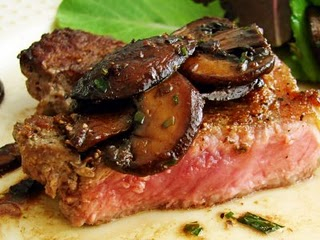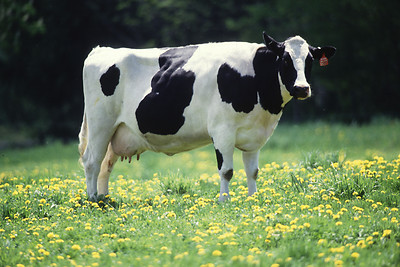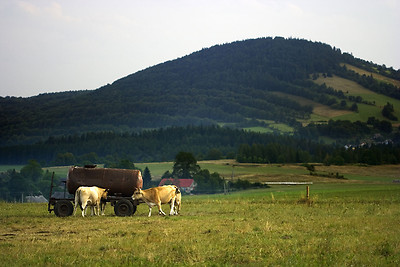Grass Fed New York Strip Steak with Warm Caramelized Mushroom Salad
 Wednesday, September 7, 2011 at 06:53PM
Wednesday, September 7, 2011 at 06:53PM  By Leslie Why Reap
By Leslie Why Reap
This recipe for New York Strip Steak with Warm Caramelized Mushroom Salad is the second in a series of videos that Chef John, from www.Foodwishes.com did on cooking various cuts of grass-fed beef.
I have transcribed the full recipe for you but you can also hear it directly from Chef John, here.
I made this a few weeks ago for friends and received rave reviews. I used two 10 ounce NY Strip Steaks (also can be labeled as boneless top loin strip steak, Kansas City steak, or strip loin) and it served 4 of us perfectly. As a testament to how easy this recipe is, I was able to pull it off in restaurant quality fashion while juggling a glass of wine, two conversations, my iPhone (in order to watch the video instructions on how to make it) and a roasting pan of Brussels sprouts. I did have help with the green salad however!
According to Chef John, he feels a simple pan searing is best. At first I was intimidated by the pan searing, it threw me off as I was expecting to grill it. The pan searing was quick, easy and produced a perfectly done, juicy and delightfully tender steak. Careful though because the searing does not take more than a few minutes per side and you do NOT want to overcook these beauties! Grass fed beef cooks more quickly as well.
The warm caramelized mushroom salad is the perfect complement. In Chef John’s words, “the earthy mushrooms really amplify the beefy flavors of the steak -- and the sherry vinaigrette and fresh tarragon are perfect conduits.” As a person that does not eat mushrooms often, I would have had seconds had there been any. So find some beautiful grass fed strip steak at your local farm, Whole Foods, or smaller scale Natural Foods store and try a recipe that will delight your palate and nourish your body!
Ingredients:
- 8 large mushrooms, sliced
- 1 1/2 tbsp. olive oil
- 1 tbsp. butter
- 1/4 cup sherry vinegar
- salt to taste
- 1 whole garlic clove, peeled and bruised
- 1 tbsp. fresh chopped tarragon
For the rest:
- 1 tbsp. olive oil
- 2 (8-oz) New York strip steaks
- salt and fresh ground black pepper to taste
Nutrition Facts Per 4 oz. serving: 353 calories: 34 grams of protein, 3.7 grams of carbohydrates, only 7 grams of saturated fat **
Making the Mushroom Salad:
- Remove mushroom stems and slice thickly (1/4-1/3 of an inch), set aside.
- In a heavy bottom sauté pan, over medium heat, combine butter and olive oil.
- Heat butter mixture until it foams (will get a slight “nutty color to top of foam) and add the mushrooms and a pinch of salt.
- Slowly caramelize the mushrooms by sautéing gently and spreading them evenly throughout pan. This will take about 20 minutes until they are nice and brown and crispy on the edges. Stir every few minutes or so.
- While the mushrooms are cooking, pound one peeled clove of garlic and add it to a medium sized bowl. To pound it, place the clove under the flat side of a butcher’s knife or large knife, and using your fist, come down onto the flat side of the blade and flatten out the clove.
- Add mushrooms to the bowl with the garlic.
- Turn off the burner and return the pan to the burner. Add the sherry to the pan. Stir sherry around and scrape the pan (deglaze) and pour sherry and bits of leftover caramelized mushrooms into the mushroom/garlic bowl.
Cooking the steaks:
- Using the same pan, over medium heat, add the olive oil.
- Pat steaks dry and generously salt and pepper both sides of steaks.
- Add the steaks to the pan, searing 2.5 – 4 minutes per side depending on your stove. Chef John says 2.5 minutes for rare but mine took more like 4 minutes a side for rare/medium rare, don’t be afraid to cut into it and check it out, do NOT overcook.
- Remove steaks from pan and add last tablespoon of butter to pan and turn off burner. Return pan to burner, add mushroom salad to pan with butter and deglaze once again, scraping up the bits of caramelized beef on the bottom of the pan.
- Add the chopped fresh tarragon to the mushroom salad in the pan and then top your steaks with the mushroom salad, distributing evenly…enjoy!



